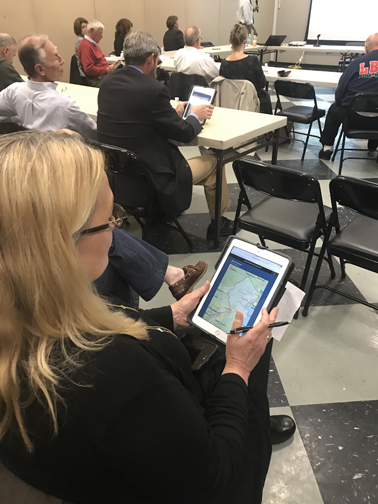
NJTPA
The NJTPA used interactive polling to gather public input
for its regional transportation plan update in 2017.Instant polling is one of those high-tech innovations that has spawned multiple internet start-ups. It’s an increasingly popular approach to engaging an audience during a presentation. The audience is asked to consider various options displayed on a presentation screen and then make a choice using their cell phones, tablets or a clicker device. The tallied results automatically appear in a bar chart or other graph for all to see.
Numerous companies are seeking to make money off of the concept — Zeetings, Poll Everywhere, Presentain, Mentimeter, Swipe, Participoll, Slido, Activote, Top Hat, Turning Point and more. Each has its own variations on the technique and offers a menu of add-on services for a fee.
Fortunately, the competition means that anyone can try out instant polling by using the free or trial access offered to woo customers. Generally, the free versions have limits of 25 or fewer users per session.
The NJTPA used Poll Everywhere in 2017 as part of outreach meetings for Plan 2045: Connecting North Jersey, its long-range regional transportation plan. In one exercise, the audience was asked to rank a list of transportation concerns, ranging from congestion to lack of transit access to needed sidewalks. People used their smartphones to respond (after accessing a Poll Everywhere website). Participants could also text responses. For those without phones, staff members made available tablets.
In 2015 the NJTPA used hand-held polling devices from the company Turning Point for similar exercises as part of a retreat for members of its Board of Trustees.
Education is a big market for instant polling. The company Top Hat quotes California State University Professor Lorna Protant: “Students already have their phones in their hands, they are probably looking at them in class, so why not turn that into something useful?” For younger students lacking phones, dedicated clicker devices are provided. In addition to polling, uses include taking attendance, conducting real time quizzes and getting feedback on the curriculum.
Business is another big market. Features for business presenters include options to gather emails and other information from audience members, crowd-source the questions people most want answered and share recorded audio and slides of presentations to those interested.
Instant polling is a subset of a wider universe of polling, survey and outreach techniques offered by companies such as Survey Monkey and Qualtrics. They gather and compile public feedback from multiple sources including social media, webpages, email, kiosks, forums and more. Companies such as Metroquest and Mindmixer specialize in assisting public agencies and community organizations in making effective use of the tools.
Mark Solof is director, public affairs and communications, at the NJTPA.